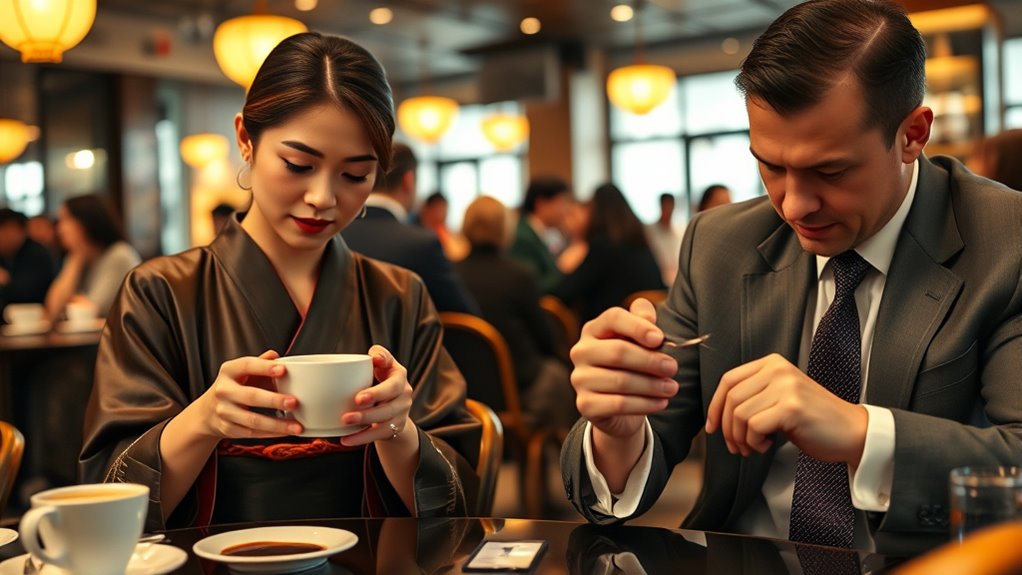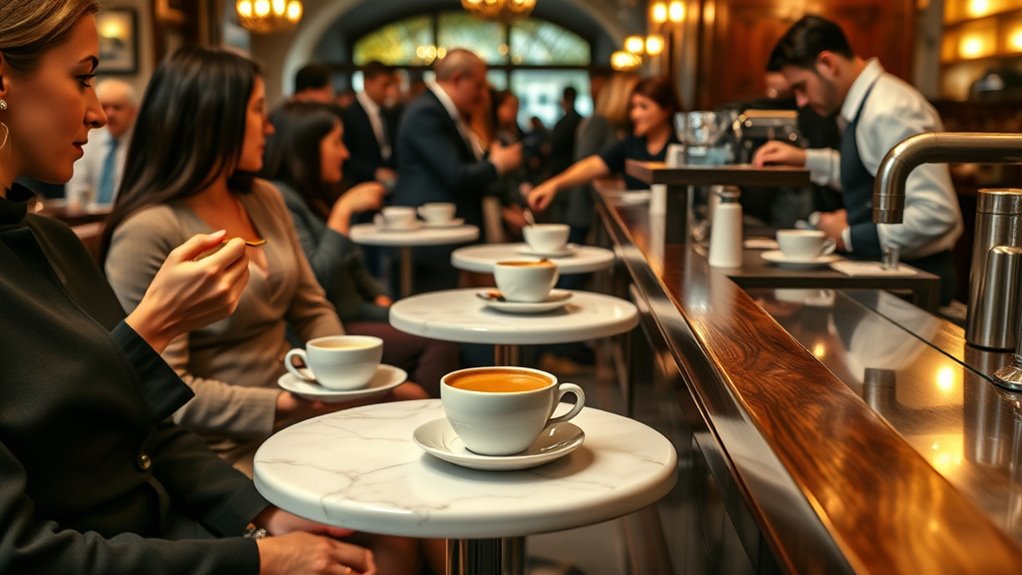When visiting cafés around the world, remember to observe local customs—such as sipping cappuccino only in the morning in Italy or respecting communal ritual in Ethiopian coffee preparations. Handle cups politely, often with both hands, and avoid loud noises or slurping in Asia. Offering a refill or graciously accepting an invitation shows manners. By understanding these subtle differences, you’ll enjoy authentic experiences—if you want to learn more, keep exploring the unique coffee traditions everywhere.
Key Takeaways
- Observe local customs, such as timing and drink choices, to avoid cultural faux pas.
- Handle cups politely, often with both hands or gentle placement, respecting regional etiquette.
- Refrain from loud slurping or improper gestures that may be considered impolite in certain cultures.
- Offer to share or refill coffee as a sign of friendliness and good manners.
- Appreciate regional brewing methods and presentation styles to show respect and deepen cultural understanding.

Sharing a cup of coffee can be a simple pleasure, but the way you do it varies greatly around the world. Different cultures have their unique coffee customs that shape how people enjoy this beloved beverage. From the way coffee is prepared to how it’s served, understanding these traditions can help you navigate social situations more smoothly. In many countries, brewing traditions play a crucial role in defining the experience, whether it’s a quick espresso shot in Italy or a slow, communal preparation in Ethiopia. Recognizing these differences shows respect for local practices and enhances your overall coffee experience.
Understanding global coffee customs enriches your experience and shows respect for local traditions.
In some places, coffee customs are deeply rooted in history. For instance, in Turkey, serving coffee involves a particular ritual—finely ground beans are brewed with water in a cezve, and the coffee is poured unfiltered, often accompanied by a glass of water and a sweet treat. It’s not just about drinking coffee; it’s about sharing a moment of hospitality. Conversely, in Scandinavian countries, coffee is often enjoyed during “fika,” a daily coffee break that emphasizes socializing over a cup of filter coffee or black brew, highlighting a relaxed and friendly approach. These brewing traditions shape not only how coffee tastes but also how it brings people together.
When you’re in a café abroad or even at home, keep in mind the local coffee customs. In Italy, a cappuccino is typically a breakfast drink, and ordering one after 11 a.m. might be frowned upon. In Japan, pour-over coffee is highly appreciated, and meticulous presentation matters. Meanwhile, in Middle Eastern countries, strong, cardamom-flavored coffee served in small cups is customary, often with a ritual that emphasizes politeness and community. Observing these customs helps you avoid unintentional faux pas and shows you respect the local culture. Additionally, paying attention to coffee serving etiquette**** can help you enjoy your experience more authentically and respectfully.
Furthermore, understanding the preparation methods used in different regions can enhance your appreciation for coffee’s cultural significance. In terms of etiquette, knowing what to do when your coffee arrives is key. For example, in many Western countries, holding the cup with both hands shows appreciation, but in some Asian cultures, placing the cup down gently and not slurping loudly is the polite way to enjoy your drink. Additionally, recognizing that in some cultures, offering to share your coffee or refilling someone’s cup is customary, indicates friendliness and good manners. Conversely, refusing an offered coffee politely is often acceptable but should be done graciously to avoid offending your host.
Frequently Asked Questions
How Do Tipping Customs Vary for Coffee Service Worldwide?
You should know that tipping customs for coffee service differ worldwide. In some countries, like the US, tipping expectations are higher, and gratuity customs suggest leaving 15-20% of the bill. In contrast, many European nations include service charges, so additional tips aren’t necessary. Always check local customs, as tipping expectations vary greatly, and being aware of these practices shows respect and appreciation for good service.
Are There Specific Dress Codes for Upscale Cafés in Different Countries?
In upscale cafés, dress codes can feel like stepping into a fashion battleground! You’ll often find that fashion expectations are strict, with some places expecting you to dress as if attending a fancy gala. From tailored suits to elegant dresses, the dress code sets the tone for sophistication. Always check ahead—whether it’s smart casual or formal attire—so you don’t stand out like a sore thumb in the world of high-end coffee culture.
Is It Polite to Share or Order Communal Coffee in Certain Cultures?
Sharing etiquette varies across cultures, and communal coffee customs often reflect local traditions. In some places, ordering or sharing communal coffee is seen as friendly and welcoming, encouraging social interaction. However, in others, it might be considered impolite or intrusive. You should observe local behaviors and ask if unsure. Respecting these norms shows appreciation for their customs, making your experience more enjoyable and culturally sensitive.
What Are the Typical Waiting Times for Coffee in Various Regions?
Waiting for coffee? Well, in some regions, you’ll find yourself sipping almost instantly, like in the US or Italy, where coffee ordering is a quick pit stop. But in places like Turkey or France, you might wait long enough to forget what you ordered—perfect for practicing patience. Remember, seating etiquette varies too; sometimes, you stand awkwardly, other times, you’re invited to linger. Patience is key, or risk being labeled a caffeine impatient!
Are There Unique Coffee-Related Gestures or Phrases to Know Internationally?
You’ll find that understanding coffee hand gestures and international coffee phrases can really enhance your experience abroad. For example, a thumbs-up often signals approval, while a nod usually means agreement. Learning simple phrases like “Can I have a coffee?” in local language shows respect. These gestures and phrases help you connect with locals, making your coffee encounters more enjoyable and culturally respectful. Just observe and try to mimic what others do.
Conclusion
As you explore coffee customs worldwide, you’ll find each culture offers its own charming nuances. Embrace these gentle differences with grace, allowing yourself to blend seamlessly into new settings. By treading softly and respecting local traditions, you create warm connections and memorable moments. Remember, a kind smile and open mind go further than any rulebook. So, savor each sip and let the world’s coffee customs enrich your journey, one welcoming cup at a time.









